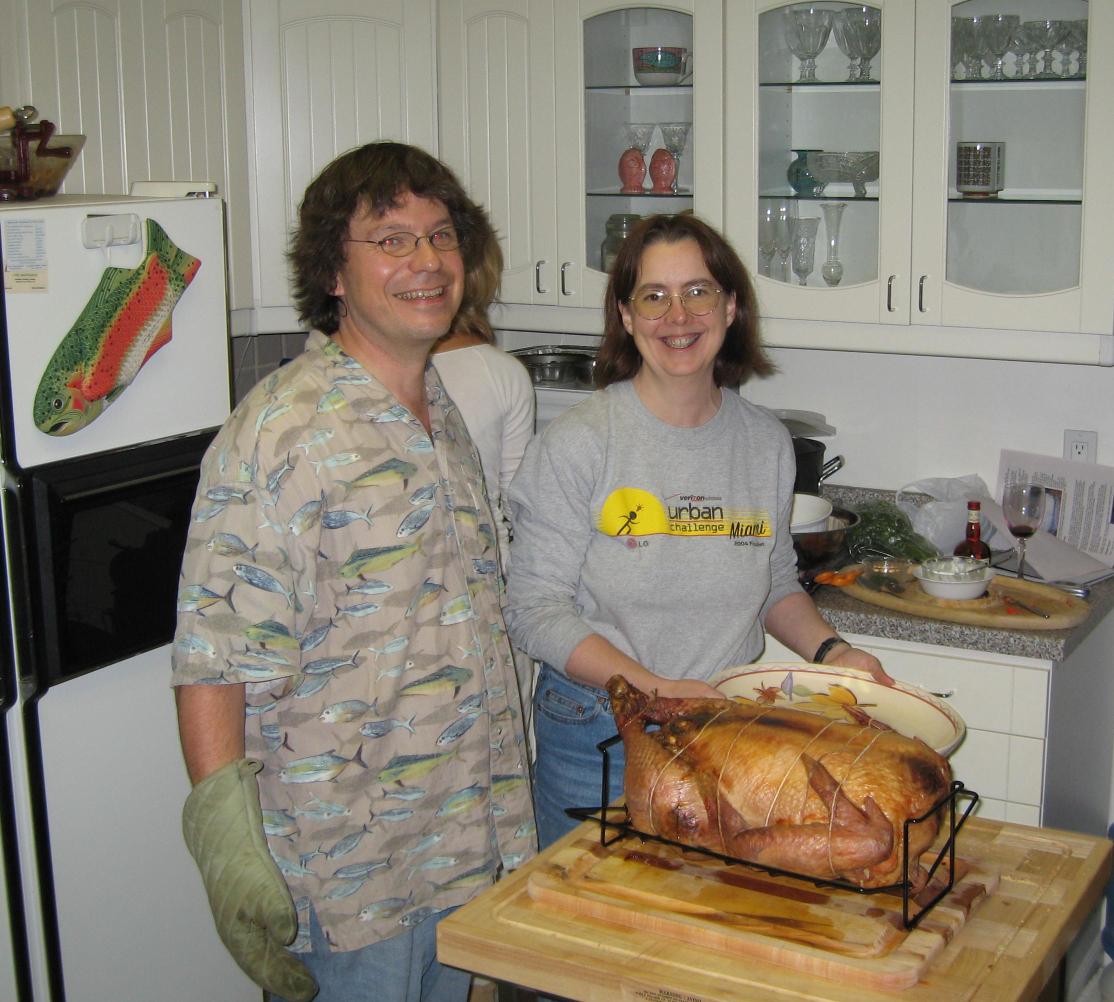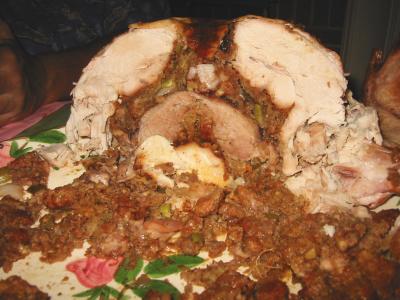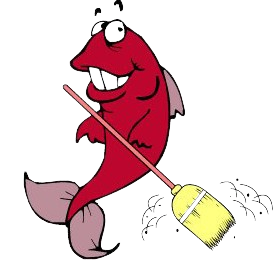TURDUCKEN (A CHICKEN IN A DUCK IN A TURKEY)
John and Lynn Salmon
 We saw a turducken recipe mentioned in a newspaper and tried it for the
first time in 1990.
("our first turducken")
It is so much better than a regular turkey that we have made
many more turduckens over the years. The juices from the
duck and the sausage stuffing really help to add flavor to the turkey and
keep it moist without basting.
This is what we do:
We saw a turducken recipe mentioned in a newspaper and tried it for the
first time in 1990.
("our first turducken")
It is so much better than a regular turkey that we have made
many more turduckens over the years. The juices from the
duck and the sausage stuffing really help to add flavor to the turkey and
keep it moist without basting.
This is what we do:
The Turducken will need to cook for approximately 9-10 hours at 225o F
so begin preparation well in advance. The fowls can be deboned the day
before and kept refrigerated overnight. Save the turkey carcass for
making stock and some duck skin to render fat.
We usually make the sausage stuffing
the night before and store it in the refrigerator.
We also bake a loaf of corn bread the night before, but
wait until morning to mix the corn bread dressing together else it
gets too soggy.
Basic Needs:
- 16-20 lb whole turkey
- 4-5 lb whole duckling
- 3-4 lb whole chicken (or use a larger chicken and place
the duckling inside it, or cheat and just use a couple chicken breasts)
- corn bread dressing
- sausage stuffing
- large roasting pan and rack
- cotton string
- large needle and cotton thread
Debone the birds:
Sharpen those knives!
Maximize your work area so you have plenty of room and light.
Use the kitchen table if there's not enough counter space.
If it is your first time deboning a fowl, it
is advisable to practice first on the chicken rather than the turkey
since mistakes will be hidden inside the bigger birds.
Rinse the turkey and remove the neck and any giblets.
Place the turkey, breast side down, on a clean flat surface.
Cut through the skin along the length of the spine.
Using the tip of a knife and starting
from the neck end, gently separate meat from rib cage on one side. Toward
neck end, cut through the meat to expose the shoulder blade; cut meat away
from and around the bone, severing bone at the joint to remove shoulder blade.
Disjoint wing between second and third joints. Leave the wing bones
and keep the wing attached to the meat.
Continue separating meat from frame, heading toward the thighbone
and being careful to keep the "oyster" (pocket of meat on back)
attached to skin, rather than leaving it with the bone. Cut through
ball-and-socket joint to release the thighbone from the carcass (bird will be
open on one side, exposing bones left to deal with). Keep the leg
attached to the meat.
Repeat boning procedure on the other side of the bird. Carefully
remove the carcass and use it to make stock. Stock is needed for
making stuffing and more stock is needed for gravy. To make stock,
put the turkey
carcass in a large pot and cover with water. Bring to a boil, then
simmer on low heat overnight.
You should end up with a flat boneless (except for wings and legs) turkey
with the skin intact in one large piece. Put the boned turkey in
a large dish or bowl and cover with plastic wrap to keep it from drying out.
Place it in the refrigerator.
Repeat the deboning process on the duckling and the chicken. With these,
you want to completely
debone all legs and wings.
Cut through flesh at the thinnest point and trim around these
bones with a knife until they can be removed.
(Since they have little meat, we usually cut off the entire wings and
add them to the stock pot.)
Both the chicken and duck will be stuffed inside the turkey and need not be
kept "perfectly" intact.
Trim excess skin and fat from the birds. Ducks, in particular,
have a lot of excess fatty skin that should be saved to render fat to be
used later for making gravy. We usually completely remove the skin from
the chicken, but keep some duck skin which adds flavor.
Prepare seasoning mix and set aside:
- 2 tablespoons salt
- 2 tablespoons paprika
- 1 tablespoon black pepper
- 1-2 teaspoons dried thyme
Prepare
sausage stuffing and
a similar amount of another stuffing such as
corn bread stuffing.
Assembly:
 At least 10 to 11 hours before dinner, assemble the Turducken.
At least 10 to 11 hours before dinner, assemble the Turducken.
Spread the turkey, skin down, on flat surface, exposing as much
meat as possible. Rub 3 tablespoons of seasoning mix evenly on meat.
Spread sausage stuffing over the turkey in an even layer approximately 3/4
inch thick.
Place duck, skin down, on top of stuffing. Season exposed duck
meat with about 1 tbsp. of seasoning mix. Spread corn bread stuffing
in an even layer (about 1/2 inch thick) over the duck.
Arrange the chicken, skin down, evenly on top of corn bread stuffing.
Season chicken meat with seasoning mix. Spread remainder of sausage
and/or corn bread stuffing on top of chicken. The assemblage will
look something like this.
With another person's help, carefully lift the sides of the
layered birds, folding the sides of the turkey together. Have a
helper hold the bird while sewing the opening down the back of the
turkey together using cotton thread. The bird may not close
perfectly, and a strip of cheese cloth can be used to help close the
"crack" in the back of the turkey so stuffing will not leak out when
the bird is turned over.
 Since the turducken has no skeleton, it must be trussed up or it
may fall apart in cooking. Tie 4-5 pieces of cotton string around the bird,
widthwise to act as skeletal support.
Turn the bird
over and place in a roasting rack inside a large roasting pan so it is
oriented breast side up and looks like a
"normal" turkey. Tie the legs together just
above the tip bones.
Since the turducken has no skeleton, it must be trussed up or it
may fall apart in cooking. Tie 4-5 pieces of cotton string around the bird,
widthwise to act as skeletal support.
Turn the bird
over and place in a roasting rack inside a large roasting pan so it is
oriented breast side up and looks like a
"normal" turkey. Tie the legs together just
above the tip bones.
Cooking:
Heat oven to 225 degrees F. Temperature control is
critical since the turducken is so massive that it has to be cooked
slowly at a low temperature to prevent burning the outside before
the interior is cooked. Using an oven
thermometer is highly recommended. We place 2-3 oven thermometers
at different locations within the oven to monitor oven temperature.
We also use a meat thermometer inside the bird to measure its internal
temperature.
Place the bird in the center of the oven and bake until a meat
thermometer inserted through to center reads 165 degrees, approximately
9 hours, though cooking times will vary depending on the size of the
birds and amount of stuffing used. Rely on temperature and not time
cooked for doneness.
There will be no need to baste, but accumulated drippings
may need to be removed from the pan every few hours so that the lower
portion does not deep fry in the hot oil.
Save pan drippings for gravy. Remove the turducken from
the oven and let cool in the pan for an hour before serving. Make
gravy according to your favorite recipe.
To serve cut bird in half. Carve crosswise so each slice
reveals all 3 meats and stuffings. Will make 15 to 25 servings.

Simple Gravy:
Take 1 cup of pan drippings plus 1 cup of flour and cook over
medium heat until "tan". Add 10 cups stock to fat/flour all at once.
Whisk thouroughly. Bring back to a boil and then simmer for 5 min.
Whisk constantly. Add salt + pepper + paprika "to taste".
Another simple gravy variation is to use
about a quarter to half cup of pinot grigio and about two to three
tablespoons of instant potatoes instead of the flour.
Test for taste and if it gets too thick
add water or more pinot.
The gravy can be made in advance and allowed to stand over low heat
for at least 2 hours (maybe more). We usually make at least two batches.
Other related foods or food ideas:

Lynn Salmon <>{
Last updated: December 9, 2021



 We saw a turducken recipe mentioned in a newspaper and tried it for the
first time in 1990.
("our first turducken")
It is so much better than a regular turkey that we have made
many more turduckens over the years. The juices from the
duck and the sausage stuffing really help to add flavor to the turkey and
keep it moist without basting.
This is what we do:
We saw a turducken recipe mentioned in a newspaper and tried it for the
first time in 1990.
("our first turducken")
It is so much better than a regular turkey that we have made
many more turduckens over the years. The juices from the
duck and the sausage stuffing really help to add flavor to the turkey and
keep it moist without basting.
This is what we do:
 At least 10 to 11 hours before dinner, assemble the Turducken.
At least 10 to 11 hours before dinner, assemble the Turducken.
 Since the turducken has no skeleton, it must be trussed up or it
may fall apart in cooking. Tie 4-5 pieces of cotton string around the bird,
widthwise to act as skeletal support.
Turn the bird
over and place in a roasting rack inside a large roasting pan so it is
oriented breast side up and looks like a
Since the turducken has no skeleton, it must be trussed up or it
may fall apart in cooking. Tie 4-5 pieces of cotton string around the bird,
widthwise to act as skeletal support.
Turn the bird
over and place in a roasting rack inside a large roasting pan so it is
oriented breast side up and looks like a 



